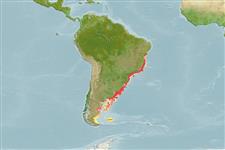Common names from other countries
>
Pleuronectiformes (Flatfishes) >
Paralichthyidae (Large-tooth flounders)
Etymology: Paralichthys: Greek, para = the side of + Greek, ichthys = fish + Greek, suffix, oides = similar to (Ref. 45335).
Environment: milieu / climate zone / depth range / distribution range
Ecologia
marinhas; estuarina demersal; intervalo de profundidade 0 - 40 m (Ref. 26375). Subtropical; 12°S - 54°S
Southwest Atlantic: Brazil. Does not occur in Argentina nor in Uruguay (Ref. 43588).
Tamanho / Peso / Idade
Maturity: Lm ? range ? - ? cm
Max length : 100.0 cm TL macho/indeterminado; (Ref. 26375); common length : 40.0 cm TL macho/indeterminado; (Ref. 6077); peso máx. publicado: 12.0 kg (Ref. 26375)
Espinhos dorsais (total) : 0; Raios dorsais (total) : 68 - 86; Espinhos anais: 0; Raios anais : 52 - 67. Pectoral fins small, about two times head on ocular side, 2.7-3.0 time head on blind side. Pelvic fins about equal in size and shape on both sides. Caudal fin double truncate (Ref. 27363).
Inhabits coastal areas, in bays and estuaries (Ref. 36453). Found over sandy or muddy substrate. Apparently, reproduction occurs during summer in small groups of 3-15 individuals. Adults are solitary. This species is very much appreciated for its taste and high commercial value.
Ciclo de vida ou comportamento de acasalamento
Maturities | Reprodução | Spawnings | Egg(s) | Fecundities | Larvas
Distinct pairing (Ref. 205).
Cervigón, F. and W. Fischer, 1979. INFOPESCA. Catálogo de especies marinas de interes economico actual o potencial para América Latina. Parte 1. Atlántico centro y suroccidental. FAO/UNDP, SIC/79/1. 372 p. FAO, Rome. (Ref. 6077)
Status na Lista Vermelha da UICN (Ref. 130435)
CITES (Ref. 128078)
Not Evaluated
Ameaça para os humanos
Harmless
Uso pelos humanos
Pescarias: espécies comerciais; peixe esportivo: sim
Ferramentas
Relatórios especiais
Baixar XML
Fontes da internet
Estimates based on models
Preferred temperature (Ref.
115969): 11.7 - 26.1, mean 16.1 (based on 150 cells).
Índice de diversidade filogenética (Ref.
82804): PD
50 = 0.5000 [Uniqueness, from 0.5 = low to 2.0 = high].
Bayesian length-weight: a=0.00646 (0.00384 - 0.01085), b=3.16 (3.02 - 3.30), in cm Total Length, based on LWR estimates for this species & Genus-body shape (Ref.
93245).
Nível Trófico (Ref.
69278): 4.4 ±0.6 se; based on size and trophs of closest relatives
Resiliência (Ref.
120179): médio(a), tempo mínimo de duplicação da população 1,4 - 4,4 anos (Preliminary K or Fecundity.).
Fishing Vulnerability (Ref.
59153): High vulnerability (60 of 100).
